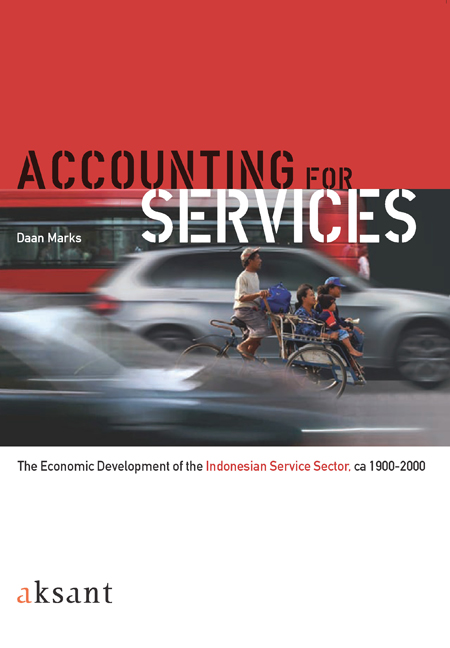Book contents
- Frontmatter
- Contents
- List of Tabels
- Acknowledgement
- 1 Introduction
- 2 National Accounting for Services in Indonesia
- 3 The Development of the Indonesian Service Sector: A Quantitative Analysis
- 4 Roads to Riches? Transportation and Economic Development in Indonesia
- 5 Involution and Growth: the Ambiguous Role of the Trade Sector in the Economic Development of Indonesia
- 6 Unity or Diversity?: Market Integration through Trade and Transport
- 7 Conclusions
- Appendices
- References
Appendix 6 - National Accounting for other Services
Published online by Cambridge University Press: 19 January 2021
- Frontmatter
- Contents
- List of Tabels
- Acknowledgement
- 1 Introduction
- 2 National Accounting for Services in Indonesia
- 3 The Development of the Indonesian Service Sector: A Quantitative Analysis
- 4 Roads to Riches? Transportation and Economic Development in Indonesia
- 5 Involution and Growth: the Ambiguous Role of the Trade Sector in the Economic Development of Indonesia
- 6 Unity or Diversity?: Market Integration through Trade and Transport
- 7 Conclusions
- Appendices
- References
Summary
The category ‘other services’ are those for which income is difficult to measure on an annual basis due to lack of useful data. Those services are the catering services, the so-called social and community services, such as medical services, education, and entertainment, and the other services, such as domestic servants. A very crude estimation procedure for this is assuming that the category ‘other services’ makes up 20 per cent of total value added in services. This is based on information from the I-O tables, which shows that on average this category indeed was roughly 20 per cent of total value added in services (see table A6.1).
A different procedure can be followed as well. From the different population censuses information was taken on the number of people working in 1) hotels and restaurants, 2) community services, and 3) other services. It is assumed that those working in sub-category 1) and 3) hardly earn more than a labourer and this wage is taken from Van Leeuwen (2007: 240-242). In sub-category 2) most people are probably rather well-educated since surgeons, teachers, etc. are part of this. Therefore it is assumed that those earn the wage of a craftsman, also taken from Van Leeuwen (2007: 240-242). This gives the benchmark estimates presented in table A6.2.
These benchmark estimates are interpolated based on both government and private expenditure on education taken from Van Leeuwen (2007: 240-242). Constant price estimates are obtained by deflation using the cpi from Van Leeuwen (2007). The results of this are presented in appendix table A6.3.
- Type
- Chapter
- Information
- Accounting for ServicesThe Economic Development of the Indonesian Service Sector, ca 1900–2000, pp. 307 - 312Publisher: Amsterdam University PressPrint publication year: 2009



